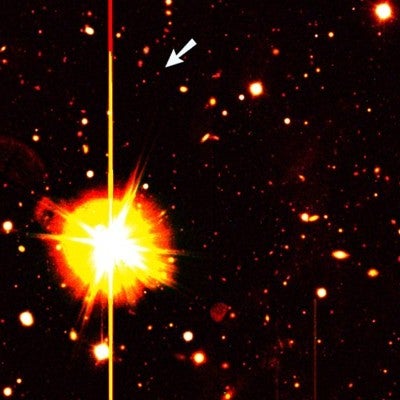An analysis by the international LIGO (Laser Interferometer Gravitational-Wave Observatory) Scientific Collaboration has excluded one previously leading explanation for the origin of an intense gamma-ray burst that occurred last winter.
The LIGO project, which is funded by the National Science Foundation, was designed and is operated by the California Institute of Technology and the Massachusetts Institute of Technology for the purpose of detecting cosmic gravitational waves and for the development of gravitational-wave observations as an astronomical tool. Research is carried out by the LIGO Scientific Collaboration, a group of 580 scientists at universities around the United States and in 11 foreign countries. The LIGO Scientific Collaboration interferometer network includes the GEO600 interferometer, located in Hannover, Germany, funded by the Max-Plank-Gesellschaft/Science and Technologies Facilities Council and designed and operated by scientists from the Max Planck Institute for Gravitational Physics and partners in the United Kingdom.
Each of the L-shaped LIGO interferometers (including the 2 km and 4 km detectors in Hanford, Washington, and a 4 km instrument in Livingston, Louisiana) uses a laser split into two beams that travel back and forth down long arms, each of which is a beam tube from which the air has been evacuated. The beams are used to monitor the distance between precisely configured mirrors. According to Albert Einstein’s 1916 general theory of relativity, the relative distance between the mirrors will change very slightly when a gravitational wave, a distortion in space-time, produced by massive accelerating objects that propagates outward through the universe, passes by. The interferometer is constructed in such a way that it can detect a change of less than a thousandth the diameter of an atomic nucleus in the lengths of the arms relative to each other.
On February 1, 2007, the Konus-Wind, Integral, Messenger, and Swift gamma-ray satellites measured a short but intense outburst of energetic gamma rays originating in the direction of M31, the Andromeda galaxy, located 2.5 million light-years away. The majority of such short (less than 2 seconds in duration) gamma-ray bursts (GRBs) are thought to emanate from the merger and coalescence of two massive but compact objects, such as neutron stars or black hole systems. They can also come from astronomical objects known as soft gamma-ray repeaters, which are less common than binary coalescence events and emit less energetic gamma rays.
During the intense blast of gamma rays, known as GRB070201, the 4 km and 2 km gravitational-wave interferometers at the Hanford facility were in science mode and collecting data. They did not, however, measure any gravitational waves in the aftermath of the burst.
That non-detection was itself significant.
The burst had occurred along a line of sight that was consistent with it originating from one of Andromeda’s spiral arms, and a binary coalescence event, the merger of two neutron stars or black holes, for example, was considered among the most likely explanations. Such a monumental cosmic event occurring in a nearby galaxy should have generated gravitational waves that would be easily measured by the ultrasensitive LIGO detectors. The absence of a gravitational-wave signal meant GRB070201 could not have originated in this way in Andromeda. Other causes for the event, such as a soft gamma-ray repeater or a binary merger from a much further distance, are now the most likely contenders.
LIGO’s contribution to the study of GRB070201 marks a milestone for the project, says Caltech’s Jay Marx, LIGO’s executive director. “Having achieved its design goals 2 years ago, LIGO is now producing significant scientific results. The nondetection of a signal from GRB070201 is an important step toward a very productive synergy between gravitational-wave and other astronomical
communities that will contribute to our understanding of the most energetic events in the cosmos.”
“This is the first time that the field of gravitational-wave physics has made a significant contribution to the gamma-ray astronomical community, by searching for GRBs in a way that electromagnetic observations cannot,” adds David Reitze, a professor of physics at the University of Florida and spokesperson for the LIGO Collaboraton.
Up until now, Reitze says, astronomers studying GRBs relied solely on data obtained from telescopes conducting visible, infrared, radio, X-ray, and gamma-ray observations. Gravitational waves offer a new window into the nature of these events.
“We are still baffled by short GRBs. The LIGO observation gives a tantalizing hint that some short GRBs are caused by soft gamma repeaters. It is an important step forward,” says Neil Gehrels, the lead scientist of the Swift mission at NASA’s Goddard Space Flight Center.
“This result is not only a breakthrough in connecting observations in the electromagnetic spectrum to gravitational-wave searches, but also in the constructive integration of teams of complementary expertise. Our findings imply that multimessenger astronomy will become a reality within the next decade, opening a wonderful opportunity to gain insight on some of the most elusive phenomena of the universe,” says Szabolcs Márka, an assistant professor of physics at Columbia University.
The next major construction milestone for LIGO will be the Advanced LIGO Project, which is expected to start in 2008. But Advanced LIGO, which will utilize the infrastructure of LIGO, will be 10 times more sensitive. Advanced LIGO will incorporate advanced designs and technologies for mirrors and lasers that have been developed by the GEO project and have allowed the GEO detector to achieve enough sensitivity to participate in this discovery despite its smaller size.
The increased sensitivity will be important because it will allow scientists to detect cataclysmic events such as black-hole and neutron-star collisions at 10-times-greater distances.










